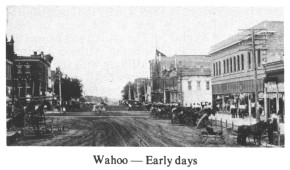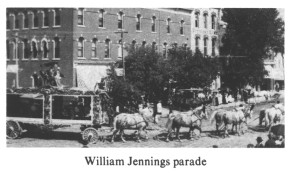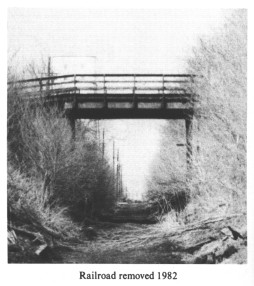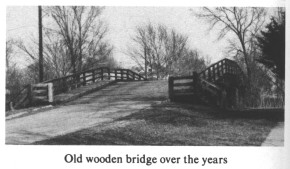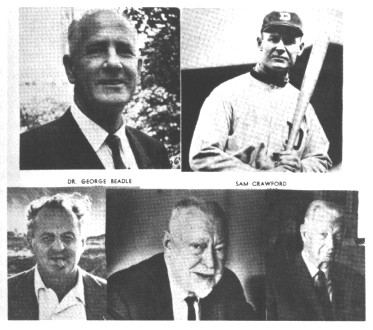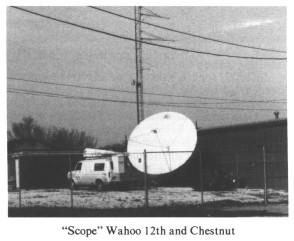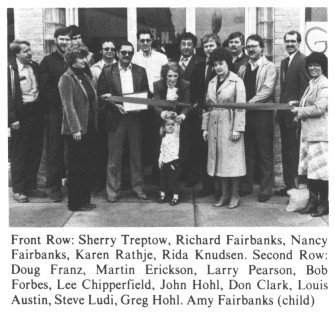 |
STOCKING PRECINCT |
|
come across the prairie into town, with its great, huffing steam locomotive. In my childhood, bands of by now greatly impoverished Indians used to camp at the edge of town, and go house to house, begging for food. Three business houses, a blacksmith house, and a schoolhouse which consisted of a single room 24 by 16 feet, with two or three residences, comprised the entire city of Wahoo when my father, Joseph Manners, brought his family here in 1873. All of these buildings, in 1873, were located on First Street, directly south of where the Burlington railroad station now stands. For some reason it was decided to change the location of the business part of town. My father built his first business house on the lots now occupied by Smith-Hultin and Anderson's firm, the streets in front of it (now called Fifth and Broadway) then being unbroken prairie land. One of the important buildings in the eyes of young people of earlier days was the old water mill down on Wahoo Creek, for the existence of this mill and dam made possible the wide expanse of water which afforded us so much pleasure. Here we fished and boated in summer, and skated in winter. by Minnie B. Manners, 1868-1954, Wahoo, Nebraska
"THE FAMOUS FIVE MEN"The small town of Wahoo is proud of five men who rose above all expectations. These men have been proud to claim Wahoo as their birthplace. Samuel Crawford was born April 18, 1880 and grew up in the North Ward area. He grew up to be known as "Wahoo Sam" and his love of baseball led him to the Baseball Hall of Fame, which he achieved in 1957. Dr. George Beadle was born south of Wahoo in 1903. Beadle's interest in science has brought him many awards. He won the famous Nobel Prize in 1958 for his work in genetics. Darryl F. Zanuck was born September 5, 1902 in Wahoo. Zanuck was enthusiastic and energetic. He was a pioneer in filmmaking and co-founder of 20th Century-Fox. He will be remembered for the film classics such as "The Grapes of Wrath," "The Jazz Singer," and "Sound of Music." Clarence Anderson was burn in Wahoo on April 12, 1891. His love of horses led to his first book, "Billy and Blaze" plus many more series of books. Mr. Anderson was listed in "Who's Who in American Art." Clarence Anderson was a well-known artist who exhibited in art galleries across the country. His paintings of horses gained national recognition. Howard Hanson was born in Wahoo October 28, 1896. His love for music led him to the Pulitzer prize for "Symphony No. 4" in 1944. He headed the Eastman School of Music at the University of Rochester in New York. He served this school for 40 years. "The Famous Five" achieved fame in a growing nation and will long be known as Wahoo's five famous sons. The accomplishments of these men could fill pages and pages. SPECIAL VISITSOn Friday, April 22, 1966, Senator Edward Kennedy came to Wahoo in a Shrine Motorcade. Senator Kennedy spoke at the John F. Kennedy College's first annual Founders Day Convocation. Over 1400 people assembled in the Field House to hear his speech. In April, 1968, Pat Kennedy Lawford was in Wahoo campaigning for her brother Robert, who was running for the presidency of the United States. In May, 1968, Robert, himself, appeared at a political rally on the streets of Wahoo. Robert was assassinated the next month in California.
LANDMARKSTwo community landmarks of long standing were destroyed by fires in the 1970's. One of these landmarks lost to flames in February of 1976 was a building that was once used as a home for the Central Bridge and Construction Company in the early 1900's. This building housed a large vault made of concrete and steel. The building was largely used for a machine shop, laundromat, and small apartment. This landmark was at the corner of 8th and Chestnut. Located at this corner is the present SCOPE cable television antenna. "Old Main" on the College Campus in Wahoo was gutted by a fire in 1971. We must not forget another landmark outside of Wahoo that started in the 1920's -- the Wanahoo Park (later called Dance Island) facilities. In 1967, the Dance Island Pavillion in the park burned, causing the passing of this recreational area. This pavillion ceased to operate in 1963, followed by a cave-in, finally a fire in 1967. CHAMBER OF COMMERCEThe Wahoo Chamber of Commerce adopted and put into force a set of by-laws on July 12, 1923. The preamble states: Because of there existing in the City of Wahoo and vicinity, lines of interest advantageous to the individual members of the community, and to the community at large, the furtherance of which can not be attended to by individuals alone, and which is not provided for out of any municipal or county funds, or by any existing representative officiary, but must be secured by special organized effort and funds, the Wahoo Chamber of Commerce is organized. In 1928, the Board of Directors included Ed Lehmkuhl, President, Rudy Anderson, Ferd Anderson, O.F. Anderson, Mart Hult, M.A. Phelps, Eric Erickson, Dr. McCreery, and C.E. Ericson. They held monthly dinner meetings that cost each person 50¢. Dues were $20 per year.
In 1931, the dues were reduced to $10 per year. For many years the Chamber worked closely with the 4-H Clubs. The Chamber sponsored a Calf Club. Each year boys and girls from ages 12-18 would register to win a calf. The only stipulation was that the winners attend Calf Club meetings, properly care for the animal, and when the calf matured, give the first-born heifer calf to the Chamber. In the years that followed, the Chamber worked closely with the city to erect a new hotel, contributed financially to Luther College, the Saunders County Hospital, and to the American Red Cross. The Chamber was also instrumental in the completion of Highway 92. The Chamber today has 100 members. Monthly meetings are held at the Eagles Club. The officers of the current Board of Directors are: President, Karen Rathje; Vice President, Larry Pearson; Treasurer, Glen Baumert; and Secretary, Sherry Treptow. Other board members are Tom Svoboda, Greg Hohl, Iown Triplett, Ray Barton. Bob Gottschalk, Macel Hoppe, Dr. Ted Japp, Mildred Wright, Larry Stunkel, Bill Pruss, and Doug Franz. The Chamber helps organize, and participates in, the annual Easter Egg Hunt, National Secretary's Day, and Teacher Appreciation Breakfast, to name a few. The Chamber has a slide-tape presentation to help advertise the advantages of living in Wahoo. The office is located in the basement of City Hall, and is staffed with a full-time Secretary-Manager, who is available to answer numerous requests by phone and letter. Services provided are: Information to Tourists, Telephone Alert Calling Tree, Santa Claus, Christmas Music, Ribbon Cuttings, a Monthly Newsletter, and Health Insurance for Chamber Members. The Chamber relies solely on the support of the business community. Keeping business in Wahoo is the primary goal. On July 12, 1983, the Wahoo Chamber of Commerce will celebrate its 60th anniversary of service to the Wahoo Community. PLANNING COMMISSIONA Planning Commission for the City of Wahoo was formed in October, 1956. The function and duty of the commission is to make and adopt plans for the physical development of the city, including any areas outside its boundaries which bear relation to the planning of the city. The commission recommends to appropriate public officials programs for public structures and improvements. It consults with, and advises, public officials, agencies, public utility companies, civic, educational, professional and other organizations. A Comprehensive Plan was adopted in 1971 and is currently being updated. Present commission members are Roger Fisher, Chairman, and Gaylen Maly, Lyle Peterson, Martin Shanahan, Jack Christensen, Jack Tillman, Tom Johnston, Jim Svoboda, and Art Gerdts. Phyllis Nozicka is secretary. WAHOO MUNICIPAL AIRPORTIn April 1944, a group of citizens and taxpayers appeared before the Mayor and Council asking for the establishment of an airport for the City of Wahoo. The Council agreed to set up funds in the budget for the purpose of acquiring a site. In July, 1945, a petition, filed by resident freeholders asking for an airport and calling for a special election to vote on bonds to be issued for airport and air navigation purposes, was declared sufficient and an election was held on September 18, 1945. Results of the election was 428 for the issuance of $25,000 Aviation Field Bonds and 228 against. Bonds were issued and a Wahoo Airport Committee, chaired by O.F. Anderson, was appointed. The site, consisting of 101.5 acres, was purchased from Lucy Fisher and Katerina Dolezal and Frank and Emma Simodynes. In 1950 a Federal grant was received and a 24' x 40' Administration Building page 121 |
| Back | Contents | Next |
The Saunders County NEGenWeb Project
